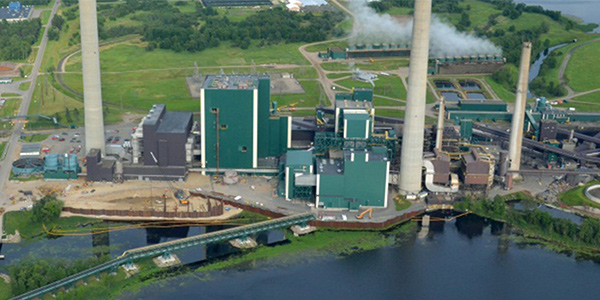Shutting down coal-fired power plants and adding 400 MW of solar and wind power in northeastern Minnesota are the primary objectives in Minnesota Power’s proposed integrated resource plan.
The state Public Utilities Commission has scheduled a virtual public hearing (E015/RP-21-33) on the plan for March 26.
The company’s 2021 IRP offers short-term (2021-2025) and long-term (2026-2035) visions for a path to being carbon-free by 2050. The company proposed increasing its renewable power output to 70% by 2030 from the current 50% level, and pledged to reduce carbon emissions by 80% and eliminate coal generation by 2035.
Bill inserts will inform customers of upcoming proceedings. Following the March 26 hearing, the commission will receive public comment until June 1. Minnesota Power will have until Aug. 2 to respond.
Since 2005, the energy company has retired, idled or reconfigured seven of its nine coal-fired generators, removing approximately 700 MW of coal-fired generation. Its 1,797-MW portfolio includes 973 MW of coal capacity at the Boswell Energy Center (BEC) and the idled Taconite Harbor Energy Center; 522 MW of wind; 172 MW of biomass/co-fired natural gas; 120 MW of hydropower; and 10 MW of solar. Transitioning from coal facilities to produce carbon-free power is the key aspect of both the short-term and long-term action plans in the IRP.
The short-term plan includes:
-
-
- retiring the Taconite Harbor Energy Center facility in September 2021;
- constructing three solar projects totaling approximately 20 MW in 2021 at the Laskin Energy Center in Hoyt Lakes, Sylvan Hydro Station near Brainerd and in Duluth;
- adapting operations at BEC Unit 3 to move to economic dispatch within the MISO market in 2021, which the company said “will result in immediate carbon reduction while supporting reliability in the region and continuing to provide economic benefits for the local host community”;
- preparing BEC 4 to transition to future economic dispatch conservation programs and electrification;
- creating a program for industrial customers to enable between 100 and 200 MW of demand response, which might be needed during peak usage periods; and
- adding 200 MW of new wind resources.
-
The long-term plan includes:
-
-
- retiring BEC 3 by 2030.
- adding 200 MW of solar resources;
- pursuing up to 50 MW of long-term DR by 2030;
- developing and implementing transmission solutions to address reliability issues related to the early retirement of BEC 3; and
- investigating options to refuel or “remission” BEC 4 and associated reliability transmission as coal operations cease by 2035. The unit is jointly owned with WPPI Energy.
-
Impacts to the Regional Economy
Most actions proposed in the IRP have potential socioeconomic impacts to northeastern Minnesota. Preparations for BEC 3’s retirement, such as the solar and transmission additions to address reliability issues, are expected to have an immediate positive economic impact, adding 173 jobs per year and increasing annual GDP by $16.7 million.
Those short-term positive impacts will be offset after BEC 3 is retired in 2029 by long-lasting negative impacts to the region, the study predicts, with the loss of 107 jobs and a $23.2 million reduction in GDP.
“This highlights the challenge for communities and the broader region (i.e., northeastern Minnesota) to offset the economic impacts caused by coal unit retirements,” the plan says.
Achieving additional carbon reduction while maintaining affordability, reliability and the northern Minnesota economy will require technological innovation and maximizing existing infrastructure, according to the IRP’s analysis. Minnesota Power’s historical roots and its future success are tied to the region’s natural resources-based economy, as it serves some of the nation’s largest industrial customers in the iron mining and forest product industries.
BEC 3’s retirement will result in a 200-MW shortfall during winter peak demand, the plan anticipates. The company said it can rely more on the industrial DR portfolio, along with firm energy purchases, to manage these periods.
To make up for closing operations at BEC 3 and ceasing coal operations at BEC 4, the plan calls for adding 400 MW of new renewable resources.
BEC and its approximately 170 employees are significant drivers of the local economy, with 2018 property tax revenue from the plant accounting for almost 70% of Cohasset’s municipal tax base, almost 20% of the Grand Rapids School District tax base and 13% of Itasca County’s tax base.
An analysis evaluating job losses and other economic impacts found that retirement of BEC 3 by the end of 2029 would produce a reasonable cost burden for customers, but retiring BEC 4 that early would produce an undue burden.
The plan also recommends a ratepayer-backed bond issue to mitigate potential ratepayer impacts associated with retiring BEC 3 and 4. (See Green Transition Sparks Comeback for Utility Securitizations.)
Advancement in technologies — specifically in lower carbon resources, renewable energy, energy storage and demand-side resources — will be available in future years to help Minnesota Power meet its goal of carbon-free power generation by 2050, according to the plan.


